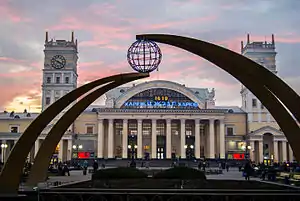Kharkiv railway station
Kharkiv Railway Station (Ukrainian: Харків-Пасажирський) is a railway station in Kharkiv, the second largest city in Ukraine.
Kharkiv-Pasazhirskyi | |
|---|---|
| Southern Railway terminal | |
 | |
| Location | Kharkiv, Ukraine |
| Coordinates | 49°59′23″N 36°12′13″E |
| Owned by | Ukrainian Railways |
| Platforms | 7 |
| Tracks | 21 |
| Construction | |
| Structure type | Standard (On Ground Station) |
| Parking | Available |
| Other information | |
| Station code | KHP |
| Fare zone | Southern Ukrainian Railways |
| History | |
| Opened | 1856 |
| Rebuilt | 1989 |
| Electrified | Yes |
| Previous names | Southern Soviet Railways |
| Passengers | |
| Daily | 260,000 (Estimated Yearly) |
History
The first station in Kharkiv was built in 1869 by famous Russian architect Andrey Ton. However, with the development of railways (especially after the opening of the road to Balashov in 1895) in 1896–1901, the station was expanded and modernized by architect I. Zagoskin, (and completed by architect J. Caune), became one of the largest in the Russian Empire.
The current (third) station is built in the "Stalin Empire style" with elements of classicism. It was opened on 2 November 1952 to replace the previous station, which was destroyed during World War II. Architects – G. I. Voloshin, B. S. Mezentsev, E. A. Lymar; engineer S. Owls. Building trust "Ugtransstroy" under the direction of M. L. Bondarenko. The volume of the station is 80,000 m3, height of the hall is 26 m, the height of the towers is 42 m, the diameter of the clock in the South tower is 4.25 m. In 1950, canopies were constructed over the platforms. Between 1978 and 1982, the building was expanded to the South (to the left of Station Square) in a contemporary style by the project of the Institute Khargiprotrans (architects Y. Murygin, L. V. Gurova, L. P. Yushkin, S. A. kukhtin, and A. N. Zhirnov). A 54-room, 16-storey hotel, "the Express" was built at the station. The station was "cosmetically" restored in 2003 for the 350th anniversary of Kharkiv. The total area of station is 32,600 m2, platforms and tunnels – 33,100 m2.
Trains
- Kharkiv – Bakhmut (Bakhmut serving as last station to Donetsk and Luhansk since 2014)
- Kharkiv – Dnipro
- Kharkiv – Odessa
- Kharkiv – Kyiv
- Kharkiv – Kryvyi Rih
- Kharkiv – Kremenchuk
- Kharkiv – Lviv
- Kharkiv – Mariupol
- Kharkiv – Baku
- Kharkiv – Kherson
- Kharkiv – Baranovichi
- Kharkiv – Odessa
- Kharkiv – Berdiansk
- Kharkiv – Astana
- Kharkiv – Moscow
External links
| Wikimedia Commons has media related to Kharkiv-Pasazhyrskyi Railway Station. |